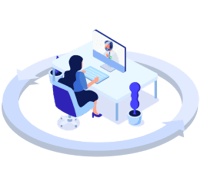Take Your Employee Training and Compliance Program Global

Expanding into new global markets often requires hiring employees from new regions. As important as it is to appeal to consumers who may speak a different language, it’s equally important to effectively communicate with your international employees as your brand grows. Training employees in new markets by localizing training content into their preferred language supports employee success and company-wide alignment.
One way to guarantee successful employee alignment is through compliance training programs. Compliance training programs safeguard employees by educating them on safety protocols, industry regulations, and relevant laws. They also provide training that helps employees perform more efficiently, and can protect organizations by showing compliance with industry laws and regulations.
Effective employee training translation localizes training materials so employees can learn in their preferred language. Since each market has different local laws, regulations and workplace expectations, localized training content must take these factors into consideration.

4 Reasons Why You Need to Localize Your HR Training and Compliance Program
1. Empower Your Employees for Success
It can be challenging to create engaging compliance and HR training programs—especially when information isn’t available in your employees’ language of choice. Employee training translation creates personalized experiences and increases employee investment in your company’s programs and courses. This means that they’re more likely to understand and apply the information from your training courses to their roles and workplace.
2. Optimize Training Efficiency
New and existing employees should have access to all necessary HR training resources in their native language. As you expand into new regions, employee training translation optimizes efficiency by taking existing training resources, and localizing them for each market. The result? Every employee receives the same high-quality training and is kept up-to-date with new developments.
3. Reduce Liability Risks
Compliance training ensures that each employee is prepared to follow all legal, regulatory and corporate protocols needed to avoid violations. Localizing your training course ensures that all global employees are able to fully understand local and regional regulations, so that employees are following relevant laws in their area.
4. Create Safe Workplaces
Employees deserve to be safe at work. By valuing compliance, a company safeguards employee welfare by teaching and following up-to-date regulations regarding workplace hazards. Compliance training also instructs employees on what a company’s expectations are for workplace behavior, DEI, and anti-harassment policies. Employee training translation makes sure those messages aren’t misunderstood so that every employee feels protected and valued.
Types of Content to Localize
Any compliance training should be localized for your global employees to ensure company-wide alignment and comprehension. Popular topics covered in compliance training include:
• Anti-harassment
• Diversity, equity, and inclusion
• Data protection and privacy
• Cybersecurity
• Business ethics
• Workplace safety training
Regardless of the specific subject matter, compliance training content can be presented in multiple formats, each with different localization requirements.
Compliance Video Courses
Employee training translation for video courses goes beyond simple language translation. It should include subtitles that are culturally and linguistically sensitive, and voiceovers that reflect regional differences in language and dialect.
Including local scenes and content that’s relevant to where employees live creates a higher level of engagement and communicates to employees that they are a valued member of the global team. Workplace expectations may also vary in different locales, so it’s important that content reflects expectations specific to their area.
Training and Course Materials
Language is a powerful tool to facilitate full internal participation in company policies and culture. Pamphlets, brochures, and safety manuals help international employees succeed in their respective roles and align with company values and objectives.
Individual industries (as well as different teams and departments within an organization) may have different content localization priorities For instance, if you’re in the fintech space, your compliance training material will most likely need to cover local laws and regulations on taxes and data security. If you’re creating training material for your marketing department, you will probably need to include local laws and regulations regarding digital advertising.
Digital Course Content
More training than ever takes place through digital channels. Powerpoints and online courses are an easily accessible format for many types of training, such as safety courses and work conduct training. That said, it’s just as important to engage employees that are training in the digital space by creating a localized experience, so that they are set up for success.
Learning and Development Media
Helping employees upskill not only enhances their job performance, it increases employee satisfaction and retention. HR departments benefit from localizing L&D resources for employees across the globe so that every employee can have access to career-development opportunities.
3 Best Practices for Localizing Compliance Training
1. Select the Right Vendor
Selecting the right partner for your employee training translation needs is the first step to a successful outcome for you and your international employees. The vendor you choose needs to understand what success looks like to you and your team. They should be aligned with the outcomes you want to achieve and the timeline you have for achieving them. An effective employee training translation partner is collaborative and takes an active role in working with your team to strategize your localization plan.
You’ll also want to look for a vendor that utilizes the right project management tools to optimize workflow and project transparency. They need to be able to effectively track relevant KPIs to ensure translation quality, accuracy, and impact. In addition, they should be able to track cost and turnaround times to keep you on budget and on top of deadlines.
2. Understand Your Market
Employee training translation works best when informed by thorough market research. Investing in market research when expanding into a new locale helps determine cultural, legal, and regulatory differences to address when developing employee training content.
Working with subject matter experts who are familiar with both the region and the industry you’re in ensures accurate and relevant content. In addition, it’s important to respect cultural and legal differences that impact what a healthy workplace looks like in a new market.
3. Invest in Scalable Technologies
As your company continues to grow into new markets, scalable translation technologies should expand with you. By utilizing smart automation, employee training translation services can reduce human error and decrease time spent on repetitive manual tasks. Another example of scalable technologies is Translation Memory (TM). Translation Memories create termbases of previously translated industry and company terms, so that they don’t have to be translated from scratch every time.
In addition, Connectors or integrations allow content to be uploaded for quick translation and, once translated, easily returned to your systems. All of this supports your ability to localize your compliance training program into new languages quickly and affordably.
Conclusion
Employee touch points like HR training and compliance programs benefit from employee training translation by supporting every employees’ understanding of their role, workplace, and company.
-%20Light%20Blue%20(11).png?width=728&height=90&name=Lilt%20(728x90)-%20Light%20Blue%20(11).png)

